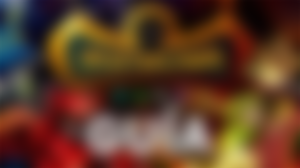What is Splinterlands? A Guide to the Magic Card NFT Game.
Hello hive friends, how are you!👋. This time I find myself doing a guide on Splinterlands, an NFT game of magic cards that is really interesting and very fun, similar to the famous and worldwide known Magic The Gathering or games like Yu-Gi-Oh!

What is Splinterlands?🤔
-Splinterlands is a collectible card game that will be very similar to the well-known Magic The Gathering or games like [Yu-Gi-Oh!](https:// www.yugioh-card.com/), where your goal is to build the best deck of cards possible to face your enemies and emerge victorious. The game system allows you to fight against other players in matches and tournaments.
In Splinterlands, each card has its own characteristics and abilities, making them more or less valuable depending on how you use them in a duel. This tells us that Splinterlands has a strong element of strategy that we must exploit to the fullest if we want to win our duels.
The best thing about Splinterlands is that each card is an NFT that lives in the HIVE blockchain, so we are facing a game with economic and high speed blockchain capacity, which greatly helps in its adoption and in fairly low cost of operations in comparison to other blockchains like Ethereum.
How does Splinterlands work?
🤔🤔🤔
If you played Magic or Yu-Gi-Oh!, you know that these games seem simple, but deep down they are not, well, the same thing happens in Splinterlands, because if you see a card game and you think it's Uno!, but The reality is that it is so complex and there are so many variables that a novice player is quickly outmatched.
First of all, you can have powerful cards in your deck, but if you don't use it wisely, those same cards can be outmatched by a skilled player exploiting their weaknesses. That said, it's pretty clear that it all starts with learning about the different types of cards and the best strategy for using them to suit the battle in front of you.
Related to: ["Play and Earn" the Secret to Mass Adoption of NFT Games](https://es.cointelegraph.com/news/play-and-earn-is-the-secret-to-mainstream- nft-gaming-adoption)
Knowing strategy and cards.
Types of cards.
In principle there are two types of cards available in Splinterlands that in turn have a "Splinter" or element that identifies them. In this case, this classification offers us the following:
Monster Cards.
Monster cards are actually people or creatures that can be called by a Summoner to fight. In this case, the monsters are the ones who physically fight within Splinterland and have the following qualities:
The level of the Monster you can use in battle is determined by your league and summoner level that called it.
Any person or creature that is called by a Summoner to battle.
If you match 2 or more monsters together you can level up the monster.
The color of the icon in the center of the card indicates the rarity of the card.
Summon Letter.
Summon cards are actually the representation of a magic user who has the ability to summon monsters to fight by her side. Among the features of the summoner we have:
The League you fight in dictates the Summoner level you can use in battle.
The Summoner's level dictates the level of Monsters you can use in battle.
A Summoner uses magic to summon monsters aligned with his Splinter.
Unless the game rules state otherwise, all summoners can summon neutral cards.You can level up by matching 2 or more summoners together.
Summoners require different amounts of cards to level up.
The color of the icon in the center of the card indicates the rarity of the card.
Splinters.
Another additional trait of the cards is that each one is defined within a "Splinter", which provides certain qualities. For example, if we use a "Fire" Splinter Summoner, this summoner will be able to call "Fire" Splinter Monsters, since that is the common Splinter between both cards.
The Splinters within the game are:
Fire.
Water.
Earth.
Life.
Death.
Dragon.
Neutral.
Card rarity.
Another important factor within Splinterlands is the rarity of the cards, which are determined probabilistically. Among the rarity levels are:
Legendary.
Legendary cards are the rarest in Splinterlands and therefore the ones you'll see the least in the game. In Packs, the normal chance to reveal a Legendary is 0.8%, but this chance can be doubled to 1.6% by using a Legendary Potion charge. In Loot, Legendary cards have the same 0.8% chance whenever a card is found in Loot (33% of the time).
Epic.
Epic cards are the second rarest card type in Splinterlands. In Packs, the chance to reveal an Epic card is 4%. The 4% chance is the same when a card is found inside a Loot.
Rare.
Rare cards have a silver border before they are revealed. At least one rare or better card is guaranteed in each Pack. The chance of revealing a Rare card when opening Packs and Loot is 20% in most sets, the number of rare cards needed to reach the maximum level of 8 is 115.
Common.
Common cards are found 75.2% of the time a card is revealed, either in a Pack or a Loot Chest. The number of Commons required to reach the maximum level of 10 varies depending on the card set.
Skills.
To complicate the card use section we have that each card has unique Abilities that can be more or less useful depending on which card you are facing. In total there are 56 unique abilities that you can find on a solo or group card.
Below is a full list of these abilities and their explanation:
No. Name Description
1
Cure
Restores a portion of the Monster's health each round. 1/3 of the maximum health of monsters is restored rounded down. The minimum is 2.
2
Affliction
When a Monster with Affliction hits a target, they have a 50% chance to apply Affliction to the target, rendering them unable to heal.
3
Burst
Deals extra damage to Monsters adjacent to the target Monster. The bonus damage is equal to the main damage / 2 rounded up. Snipe works well with this ability.
4
Blind
Enemy attacks have an increased chance (15%) to miss.
5
Clean
Remove all negative effects on the Monster in the first position of the friendly team. However, it does not remove the summoner's debuffs.
6
point blank range
Monsters with the close range ability can make ranged attacks from the first position.
7
Crippled
Each time an enemy is hit by a crippled monster, they lose maximum life. If the crippled monster is cleaned, it will recover 1 health for each time it has been crippled since the last cleanup.
8
Demoralize
Reduces the melee attack (by 1, but cannot be lower than 1) of all enemy monsters.
9
Dispel
When this monster hits an enemy, it removes all positive status effects on that enemy.
10
divine shield
The first time the Monster takes damage from a monster or an earthquake, it is ignored. The poison does not activate the divine shield, it will still reduce 2 HP.
11
Dodge
Has an increased chance (25%) to evade melee or ranged attacks.
12
double whammy
The monster attacks twice each round.
13
Infuriate
Increased melee attack and speed when damaged. Values are multiplied by 1.5 and rounded.
14
Flying
Has an increased chance (25%) to evade melee and ranged attacks from monsters that don't have the Flying ability.
15
cut in half
Each time this Monster hits a target, the target's ATK is halved (rounded down).
16
headwinds
Reduces the ranged attack of all enemy monsters (by 1, but cannot be less than 1).
17
Immunity
This monster is immune to negative status effects. Still affected by summoner attack debuffs.
18
Inspire
Give all friendly monsters 1 melee attack.
19
Knock out
Does double damage when attacking a stunned enemy.
20
Last Stand
Gains increased stats if it's the only monster alive on the team. Values are multiplied by 1.5 and rounded.
21
life leech
A monster's health increases each time it damages an enemy monster's health in proportion to the damage dealt. It works with a bang.
22
magic reflection
When hit with magic damage, it reduces magic damage to the attacker. Equal to the attacker's damage / 2 rounded up. It doesn't matter if the monster hit by the magic has void, just look at the attacker's damage.
23
Opportunity
Monsters with the Chance ability can attack from any position and will target the enemy Monster with the lowest health.
24
Press
Does double damage when attacking an enemy that has no attacks.
25
Phase
Magical attacks can miss this Monster (using the same hit/miss calculation as melee and ranged attacks).
26
Drilling
If melee or ranged attack damage exceeds the target's armor, the rest will deal damage to the target's health.
27
Poison
Attacks have a chance (50%) to apply poison, dealing auto damage to the target at the start of each round after the poison is applied. The poison does 2 damage each end of turn and is not affected by shield or void.
28
Protect
All friendly monsters gain 2 armor.
29
Reach
Melee Attack Monsters with the Reach ability can attack from the second position of the team.
30
Redemption
When this Monster dies, it deals 1 damage (melee) to all enemy monsters.
31
Repair
Restores some armor to the friendly Monster whose armor has taken the most damage.
32
Resurrect
When a friendly monster dies, it comes back to life with 1 health. This ability can only be activated once per monster using the ability per battle.
33
Retaliate
When hit with a melee attack, retaliating monsters have a (50%) chance to attack their attacker. The chain is possible.
4
return fire
When hit with a ranged attack, monsters with return fire will return reduced damage to their attacker. Equal to the attacker's damage / 2 rounded up.
35
Oxide
Reduces the armor of all enemy monsters by 2.
36
scavenger
Gain 1 maximum health each time a monster dies.
37
To break
The target's armor is destroyed when hit by an attack from Mangle Monsters. The effect is not affected by divine shield.
38
Armor
Melee and ranged attack damage reduced. Attack value is halved (and rounded up) before dealing damage.
Examples:
A monster with 1 attack deals 0 damage
A monster with 2 attacks deals 1 damage
A monster with 3 attacks deals 2 damage.
Thorn Damage = 2, Shield reduces damage to 1
39
Silence
Reduces the magic attack of all enemy monsters by 1.
40
Slow
Reduce the speed of all enemy monsters by 1. The minimum speed is 1.
41
Trap
Attacking enemies with Fly removes the Fly ability and cannot miss those who currently have Fly. It can still miss on unflying monsters or monsters that have already been caught.
42
Furtive
Target the last monster on the enemy team instead of the first monster.
43
Snipe
Target enemy monsters with ranged, magic or no attack that are not in the first position.
44
Strengthen
All friendly monsters have health increased by 1.
45
Stun
When a Stun Monster hits a target, it has a 50% chance to stun the target causing it to skip turns until the stun monster gets its turn. This can cause some monsters to lose 2 turns or 0 turns.
46
Speed
All friendly monsters have increased speed.
47
healing tank
Restores a part of the Monster to the first health position each round. 1/3 of the maximum health of monsters is restored rounded down.
48
Taunt
All enemy monsters target this monster (if they can). Does not affect monsters with range that are in 2nd position.
49
thorns
When hit with a melee attack, it deals (2 melee) damage to the attacker.
50
Trample
When a Trample Monster hits and kills its target, it will perform another attack on the next Monster on the enemy Team. If the frontline monster dies and then resurrects, it will continue to attack the second monster, ignoring the first.
51
triage
Heals the friendly Monster in the backline that has taken the most damage. Heal is max health / 3 rounded down. The minimum is 2.
52
TrueStrike
This Monster's attacks cannot miss. The blind handicap will also have no effect.
53
Empty
Magic attack damage reduction. Same effects as shield, but with magic damage.
54
Void Armor
Magic attacks hit this monster's armor before it hits its health.
55
Weaken
Reduce the health of all enemy monsters (by 1, but cannot be lower than 1). An exception to this is if the enemy monster scavenges. If you have less than 1 health and then scavenge, your max health will stay at 1.
Leagues.
Splinterlands features six (06) leagues covering a wide range of collections, experience, and abilities. A new player in their first week will find themselves in the Rookie and Bronze leagues, while more experienced players battle it out each season for the coveted Champions League I.
Even if a player has all the maximum level cards, the cards he can use in battle are always limited to the maximum level his current League allows. The rewards increase as players move up the leagues, but so does the complexity of the strategy and the difficulty of the competition. Leagues are also limited by a player's Collection Power, which can always be increased by buying or renting more cards.
When a player crosses the threshold of a new League, they are given the option to advance or continue fighting in the same League. If you stay in the same League, it will be more difficult to gain points because almost everyone you face will have lower League ratings than you, but you will be able to fight for the leaderboard of your current League.
In this case, the leagues are distributed as follows:
Rookie League: With a rating of 0 to 99.
Bronze League: divided into three different ratings:
Bronze I: with a rating of 100 to 399.
Followed by Bronze II: with a rating of 400 to 699
Finally, Bronze III: with a rating of 700 to 999.Silver League: divided into three different ratings:
Silver I: with a rating of 1000 to 1299.
Silver II: with a rating of 1300 to 1599.
Finally, Silver III: with a rating of 1600 to 1899.Gold League: divided into three different ratings:
Gold I: with a rating of 1900 to 2199.
Gold II: with a rating of 2200 to 2499.
Finally, Gold III: with a rating of 2500 to 2799.Diamond League: divided into three different ratings:
Diamond I: with a rating of 2800 to 3099.
Diamond II: with a rating of 3100 to 3399.
Finally, Diamante III: with a rating of 3400 to 3699.Champion League: divided into three different ratings:
Champion I: with a rating of 3700 to 4199.
Champion II: with a rating of 4200 to 4699.
Finally, Champion III: with a rating of 4700 and up.
With this, you already have the basic knowledge about abilities and cards that you can find, how to use them and how you can be the winner in a duel within Splinterlands. Additionally, add that the total number of Summon and Monster cards in the game already exceeds 300 cards and the number continues to increase, so the probabilities are practically infinite.
SPS token, DEC and rewards.
Splinterlands has two tokens with very specific functionalities that we will explain below:
SPS token and the governance of the Splinterlands.
The Splintershards Token (SPS) is a cryptocurrency governance token that provides increasing levels of decision-making and control over the product to the player base, asset owners, and other stakeholders. This is possible because Splinterlands has created a DAO (Decentralized Autonomous Organization) that uses a series of smart contracts published on Binance Smart Chain (BSC).
In order to manage the cross-chain system of the DAO (in BSC) and the smarts contracts of the game Splinterlands (in Hive), a system of decentralized oracles that allow users or other entities chosen by the holders of the SPS tokens, to execute software that will transmit relevant information about the transactions of the game in the Hive blockchain to the smart contracts of the SPS tokens in BSC and vice versa, with this action those who run this software will receive SPS token rewards. This is a way to make a profit using Splinterlands, without having to play.
SPS holders (which may be players) can stake their SPS tokens to a software maintainer, thereby receiving rewards based on their staking. On the other hand, the SPS token has a maximum circulation of 3 billion tokens and at the time of writing (Aug 12, 2021), the value per token is $0.3108.
DEC token and in-game rewards.
In-game rewards (for winning battles) are given in DEC tokens (Dark Energy Crystals). This is an ERC-20 type token that has trading space on platforms like Tron, Hive, Steem, BSC and Ethereum. In other words, there are smart contracts on these blockchains that allow you to interact with the token for its purchase-sale and exchange.
To earn DEC you must have in your possession the so-called Summoner's Spellbook, as this is a requirement to be eligible for reward delivery.
Ranked Battles are one of the main ways that DEC occurs. There is always a pool of DEC rewards, and that pool is constantly divided among the current winning players. This is why the amount of DEC that can be earned per win always fluctuates. The amount rewarded to each player always depends on the total amount of DEC in the pool, as well as various other factors. The reward pool produces 1 million DEC tokens daily, and from there these are doled out to the winners of battles. of that day.
DEC tokens have a controlled exchange rate that tells us that 1,000 DEC = $1. When this relationship is broken, the system automatically starts burning tokens to maintain the exchange rate.
If you want to exchange the token, one of the easiest ways is through Uniswap, for which you just have to go to its interface and import the token, or click on this [link](https://app.uniswap. org/#/swap?inputCurrency=0x9393fdc77090f31c7db989390d43f454b1a6e7f3) and go directly to the exchange pair.
How can I earn money in Splinterlands?
Well, the most common ways to earn money in Splinterlands are:
Daily Quest: consists of winning 5 games using one of the specific attributes. As a reward you can get up to 20 cards which you can then sell on the market for DEC.
DEC: Every battle you win will earn you DEC tokens, which you can then exchange for other tokens. Remember, the fee is 1,000 DEC = $1.
Season Rewards: This is another way to earn money. When you participate in a season you must participate in the battles that are indicated and go up until you achieve a certain classification which will allow you to receive cards as rewards. These rewards range from 5 to 150 cards.
Community tournaments.
Through the card buying and selling market.
The other option is to become an SPS staker or oracle, but in this case you are not playing and its configuration is quite technical.
How do I get started in Splinterlands?
To start playing within Splinterlands all you have to do is go to its official website.
Once on the web you must go to "Log in" and with it you must choose a Web3 wallet to connect, in this case, we will use MetaMask connected to the Binance Smart Chain network, to take advantage of low commissions and the highest confirmation speed of transactions.
Once we are inside the system, all we have to do is click on "Play Now":
With this we are already inside the game, and we can see all the elements of it. For example, we can enter the market and see all the card options that are available within it.
Also from here we can buy the Spellbook (Book of Enchantments) which is the first thing that we must buy in order to start our journey in Splinterlands. Interestingly, the book can be purchased by gift code, crypto and fiat using PayPal, and with it you get your first 30 cards.
That said, the interface of Splinterlands is well crafted, it's very clear and easy to navigate, so you won't have any problems moving around it, as its learning curve is in understanding and handling your cards to have the best strategy at all times. . In short, it's a game designed to be enjoyed to the fullest (or suffered if you can't figure it out).
How much money should I invest in Splinterlands?
As for the first investment that every player must make within Splinterlands is the Spellbook, as soon as you enter it is the first thing you must buy if you want to play. Its value of $10 places it in a fairly accessible price range, so it will not be a problem to reach it.
Once this is done, you have two options:
Buy the initial pack of cards (a total of 30 cards), pray for luck and draw a good deck and start the battle to win DEC.
Buy cards in the market, where you can choose which cards you want, balance them and start battling.
The first option is the cheapest, since its value is $10, and for that value it can give you very good surprises, since the packs can come with high-level cards that can give you an important game boost for a player. newbie. On the other hand, the second option allows you to customize your choice, balance the selection and start with a good deck, although this is for those who fully understand the dynamics of the game. Also, this second option is the most expensive as a card can cost anywhere from $1 (for common cards) to over $3,900 for a high level rare card.
So How much do I have to invest? Well, the minimum is $10, which is not an exorbitant value. However, keep in mind that the battles at this time are usually quite disparate due to the number of people playing, the availability of good cards in the market to good prices and the different ways to earn money within Splinterlands. In any case, the minimum to start is $10 and these can be multiplied a lot from the beginning if you have some luck, and if you play, then you can get more value.
Related: Play-to-earn games are the catalyst for this bullish period in markets
This has been all my friends, I hope you liked my splinterlands guide.😉
Tell me, did you like the content? if so, vote and comment on this post
See you in the next post.👋

your vote is important.

Posted Using PEAKD


